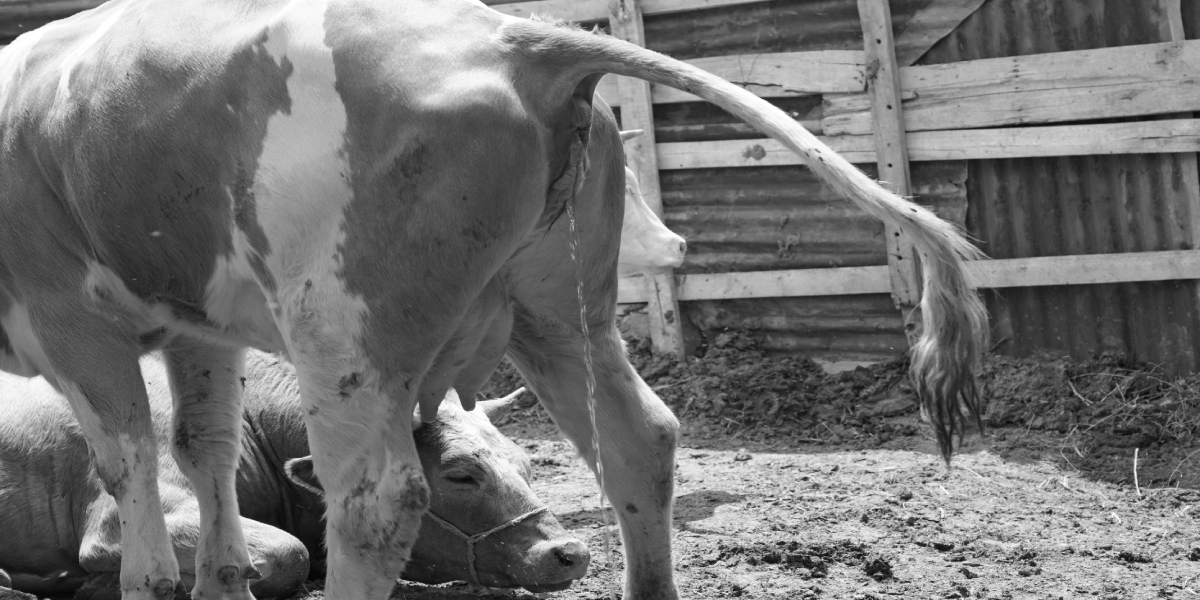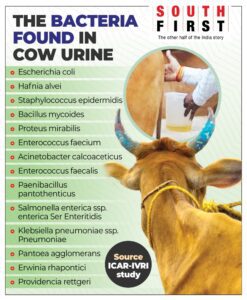ICAR-Indian Veterinary Research Institute scientists found cow urine contained harmful bacteria and was unfit for human consumption.

The study has found at least 14 types of harmful bacteria in urine samples taken from cows and bulls. (iStock)
Cow urine is used in Hindu religious ceremonies for its “purifying properties” and is now being promoted by government bodies; and there are those who even urge people to drink it.
The Cow Commission of India, or the Rashtriya Kamdhenu Aayog, claims that diseases like psoriasis, skin disorders, eczema, arthritis, inflammation, leprosy, etc, can be treated by milk, dung, and urine of the cow.
And during the pandemic, BJP lawmaker Pragya Thakur said that drinking cow urine could help prevent Covid-19, adding that recommendation had scientific backing.
“Research has already established it,” she had said.
However, scientists at the Indian Veterinary Research Institute (IVRI) — part of the Indian Council of Agricultural Research (ICAR), which itself is under the Union Ministry of Agriculture and Farmers Welfare — have found in a study that cow urine contains harmful bacteria and is unfit for human consumption.
“The urine of some individuals irrespective of sex and breed or species might be inhibitory to a select group of bacteria, but the belief that holy cow urine is antibacterial can’t be generalised. In no case can fresh urine be recommended for human consumption,” the study has concluded.
It also shows that some of the bacteria can not only cause severe — and even fatal — infections, and many of them can develop resistance to antibiotics, making treatment difficult.
In India, cow urine has been traditionally used for various purposes, including as a disinfectant, fertiliser, and even in some traditional medicines.
However, it is important to note that the medicinal benefits of cow urine have not been scientifically proven.
“In our society, cow urine is said to be beneficial for our health, but we have to scientifically understand how,” the lead researcher of the study, Dr Bhoj Raj Singh, told South First.
“People say that it helps in controlling diseases. So, we did a study to find out. We included human and buffalo urine to compare them with cow urine, and each sample contains bacteria,” he noted.
This study was conducted to assess the presence of potentially pathogenic bacteria and to determine the antibacterial properties of cow urine vis-a-vis human and buffalo urine using standard bacteriological methods.
Singh and his three PhD scholars conducted the research between June and November 2022 on three types of cows: Sahiwal, Tharparkar, and Vindavani (crossbreed) from local dairy farms.
They also took samples from buffalo and humans for the study.
The study found at least 14 types of harmful bacteria in urine samples taken from cows and bulls.
It indicated that antibacterial activity in the urine of cows may be the trait of an individual bovine specimen, but not the trait of a breed of the cow.
”The statistical analysis proved that antibacterial activity in buffalo urine was superior to cow urine,” said the study.
“The basic concept of urine is that the sample should be sterile (free from bacteria). When someone is suffering from some disease, doctors ask the patient to go for a urine test and find out the reason for the disease after determining the type of bacteria found in urine,” explained Singh.
He added that they found bacteria in the cow and buffalo, which meant that the animal might have looked healthy, but was actually not,
“Bacteria were sitting in their urinary tract after infecting the animal, and many of these bacteria cause typhoid and pneumonia in humans,” said Singh.
He added that many ayurvedic or naturopathy doctors suggest that people consume urine as an immunity booster.
“If a patient is going to a doctor, it means that they are already immunocompromised. Drinking cow urine on top of it could bring more bacteria into the body,” said Singh.
He also said that he would not suggest that anyone consume urine in any circumstances, but if someone had to, they should do so after purifying it.
“People should understand that when they consume fresh urine directly from the animal, it will be definitely harmful,” said Singh.
 Many of the bacteria found in the urine of the animals lead to severe diseases such as kidney stones, kidney failure, pneumonia, and respiratory infections. They could even cause diseases in fish and even plants.
Many of the bacteria found in the urine of the animals lead to severe diseases such as kidney stones, kidney failure, pneumonia, and respiratory infections. They could even cause diseases in fish and even plants.
Different types of bacteria which were found in the cow urine are:
Escherichia coli: This type of bacteria is commonly found in the intestines of humans and animals.
While many strains of E coli are harmless, some strains can cause illnesses like food poisoning and urinary tract infections (UTIs).
In extreme cases, the infection can cause stomach cramps, diarrhoea, and vomiting. In severe cases, it can lead to kidney failure and even death.
Hafnia alvei: It is commonly found in the environment, particularly in soil and water.
Hafnia alvei have been associated with infections in people who are immunocompromised or have other underlying health conditions.
These infections can occur in various parts of the body, including the urinary tract, bloodstream, and respiratory system, and can cause symptoms such as fever, pain, and inflammation.
In food products, Hafnia alvei can cause spoilage and can lead to the production of histamine, which can cause allergic reactions in some people.
Staphylococcus epidermidis: It is commonly found on human skin and mucus membranes.
However, Staphylococcus epidermidis can sometimes cause infections, particularly in people with weakened immune systems or those who use medical devices such as catheters, prosthetic joints, or artificial heart valves.
These infections can be difficult to treat because Staphylococcus epidermidis is often resistant to antibiotics.
Bacillus mycoides: It can sometimes be associated with infections, particularly in people with weakened immune systems or those with medical devices such as catheters or prosthetic joints.
These infections can be difficult to treat because Bacillus mycoides are often resistant to antibiotics.
Proteus mirabilis– Infections caused by Proteus mirabilis can lead to symptoms such as fever, pain, UTI, and inflammation.
Proteus mirabilis is also known for its ability to produce a type of enzyme called urease, which can break down urea into ammonia and carbon dioxide.
This can lead to the formation of kidney stones in some people with UTIs.
Enterococcus faecium: Enterococcus faecium infections can range from mild to severe, and can cause urinary tract infections, bloodstream infections, and surgical site infections, among others.
Enterococcus faecium is known for its ability to develop antibiotic resistance, particularly to vancomycin, which is a last-resort antibiotic used to treat serious infections.
Acinetobacter calcoaceticus: It is known for its ability to survive in harsh environmental conditions and can persist on surfaces for extended periods of time.
Acinetobacter calcoaceticus is considered an opportunistic pathogen, which means that it typically only causes infection in individuals who are immunocompromised or have other underlying health conditions.
It is known to cause a range of infections in humans, including pneumonia, bloodstream infections, UTIs, and wound infections.
It also has the ability to develop resistance to multiple antibiotics, making treatment difficult.
Enterococcus faecalis: This bacteria can cause UTIs, bloodstream infections, endocarditis (inflammation of the heart lining), and wound infections, among others.
Like other enterococci, Enterococcus faecalis is known for its ability to develop antibiotic resistance.
Paenibacillus pantothenticus: It is generally considered non-pathogenic and does not cause infections in humans.
There have been rare reports of infections in immunocompromised individuals. These infections have included wound infections, sepsis, and meningitis.
Salmonella enterica ssp. enterica Ser Enteritidis: Symptoms of a Salmonella enteritidis infection typically include diarrhoea, fever, and abdominal cramps, which usually develop within 12 -72 hours after exposure to the bacteria.
A group of these bacteria also causes typhoid. In most cases, the infection resolves on its own within a few days to a week.
Although, severe infections can occur particularly in young children, older adults, and people with weakened immune systems.
Klebsiella pneumoniae ssp. Pneumoniae: It is often associated with healthcare-related infections, particularly in hospital settings where patients may have weakened immune systems or invasive medical devices.
The bacterium is known to have a high level of antibiotic resistance, making treatment of infections caused by this subspecies more difficult.
Pantoea agglomerans: It has been seen in rare cases of human infections, including wound infections, UTIs, and sepsis, particularly in immunocompromised individuals or those with underlying medical conditions.
The bacterium is also known to cause infections in plants, including soft rot and blight.
Erwinia rhapontici: While E rhapontici are generally considered non-pathogenic to humans, they have been implicated in rare cases of human infections, particularly in immunocompromised individuals.
The bacterium is also known to cause infections in plants, including soft rot and blight.
Providencia rettgeri: While P rettgeri is generally considered non-pathogenic to healthy individuals, it has been implicated in rare cases of human infections, including UTIs, wound infections, and sepsis.
The bacterium is also known to cause infections in animals, including sepsis in fish and respiratory infections in birds.

Jul 26, 2024

Jul 26, 2024

Jul 26, 2024

Jul 26, 2024

Jul 26, 2024

Jul 26, 2024